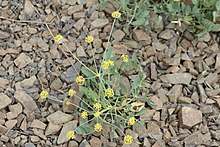Lomatium nudicaule
| Lomatium nudicaule | |
|---|---|

| |
| Scientific classification | |
| Kingdom: | Plantae |
| Clade: | Tracheophytes |
| Clade: | Angiosperms |
| Clade: | Eudicots |
| Clade: | Asterids |
| Order: | Apiales |
| Family: | Apiaceae |
| Genus: | Lomatium |
| Species: | L. nudicaule
|
| Binomial name | |
| Lomatium nudicaule | |
Lomatium nudicaule is a species of flowering plant in the carrot family known by the common names pestle lomatium,[1]: 110 [2] barestem biscuitroot, Indian celery and Indian consumption plant. It is native to western North America from British Columbia to California to Utah, where it is known from several habitat types, including forest and woodland. It is a perennial herb growing up to about 70 centimetres (28 in) tall from a thick taproot. It generally lacks a stem, the inflorescence and leaves emerging from ground level. The leaves are made up of many dull green, waxy lance-shaped leaflets each up to 9 cm long. The inflorescence is borne on a stout, leafless[3] peduncle widening at the top where it blooms in an umbel of yellow or purplish flowers.

Uses
This plant is a traditional source of food for many Native American groups, and its parts are used medicinally, including as a treatment for tuberculosis.[4] It also has been used ceremonially in association with the fishing and processing of salmon among peoples of southwestern British Columbia and Washington. For example, the W̱SÁNEĆ (Saanich), who called it qexmín, burn the seeds in a fire or on a stove when drying the salmon. Among other peoples also, including the Kwakwaka'wakw and Nuu-chah-nulth, the seeds are burned as an incense at funerals and chewed by singers to ease their throats.[5]
References
- ^ Great Basin Wildflowers, Laird R. Blackwell, 2006, Morris Book Publishing LLC., ISBN 0-7627-3805-7
- ^ Barestem Biscuitroot, USDA
- ^ Taylor, Ronald J. (1994) [1992]. Sagebrush Country: A Wildflower Sanctuary (rev. ed.). Missoula, MT: Mountain Press Pub. Co. p. 96. ISBN 0-87842-280-3. OCLC 25708726.
- ^ "Ethnobotany". Archived from the original on 2012-02-25. Retrieved 2009-08-21.
- ^ Turner, Nancy J. The Earth's Blanket. Douglas & McIntyre, 2005, p.48-50
External links
- Calflora Database: Lomatium nudicaule (Barestem biscuitroot, Pestle lomatium, Pestle parsnip)
- Jepson Manual eFlora treatment of Lomatium nudicaule
- USDA Plants Profile for Lomatium nudicaule (barestem biscuitroot)
- UC CalPhotos gallery
n
- Articles with short description
- Short description is different from Wikidata
- Articles with 'species' microformats
- Commons category link is on Wikidata
- Taxonbars with automatically added basionyms
- Articles with J9U identifiers
- Lomatium
- Flora of the Northwestern United States
- Flora of British Columbia
- Flora of California
- Flora of Nevada
- Flora of Utah
- Flora of the Great Basin
- Natural history of the California chaparral and woodlands
- Taxa named by Frederick Traugott Pursh
- Taxa named by John Merle Coulter
- Flora without expected TNC conservation status
- All stub articles
- Apiaceae stubs